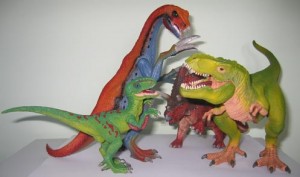Grouping and Classifying Prehistoric Animals
For reception aged children giving them a collection of colourful dinosaur models to sort out can be a great exercise in helping to teach children to distinguish and sort objects based on their appearance and properties. Young children often have a fascination for prehistoric animals and a number of Foundation Stage children show a surprising degree of prior knowledge when asked to talk about dinosaurs. From as young as three years, almost as soon as children begin to develop a sense of independent play, so their knowledge of animals including dinosaurs seems to grow.
Dinosaur Counting
When working with children in the 4-5 years age bracket we like to use the dinosaur models to help them sort them out into different colours, then we challenge more confident learners to see if they can think of another way in which the dinosaurs can be sorted.
Sorting and Grouping Dinosaurs
Picture credit: Everything Dinosaur
Dinosaur Sorting
The teacher or learning support provider can prompt where necessary and once the dinosaurs have been sorted into groups, counting can be introduced to see how many dinosaurs are in a bigger group when compared to a smaller one. Sorting out dinosaurs by looking at and comparing the size of their various body parts can be a good way to introduce differentiation in the class, with more capable learners challenged to consider sorting the dinosaurs into meat-eaters and plant-eaters based on their appearance.
Purchase dinosaur models for schools here: Dinosaur Toys and Gifts from Everything Dinosaur.
Confident learners can be given a reference book about dinosaurs and asked to find pictures in the book that match the prehistoric animal models on the table.
Introduce Matching Using a Dinosaur Book Supports Differentiation

Ten super prehistoric animal models in the set. Prehistoric animal models ideal for matching games. Picture credit: Everything Dinosaur
Picture credit: Everything Dinosaur
The models can also be used beyond Key Stage 1. For example one of objectives of the new science curriculum is to introduce how animals are classified, Key Stage 2 children can utilise the models to help build a dinosaur classification key and make modifications to their key in the light of independent research. For example, one key designed by Year 3 children, was re-designed when they learned that dinosaurs lived at different times. The key was split into Jurassic and Cretaceous dinosaurs. Such a lesson plan permitted plenty of extension activities as the pupils made changes to their classifications in the light of further study.


